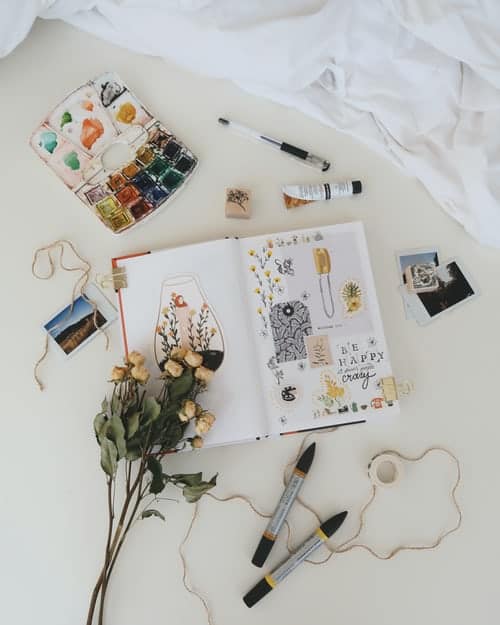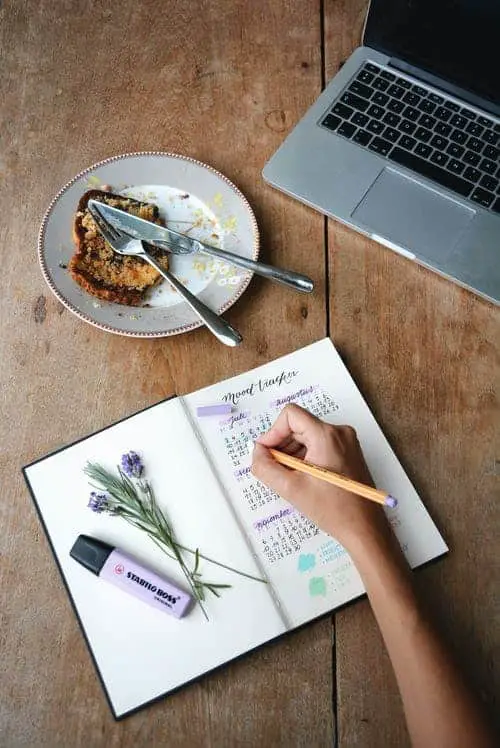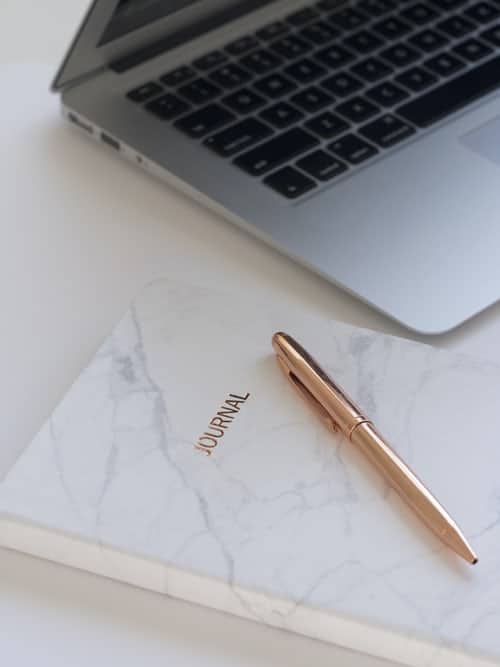How to Start a Journal: The Total Beginner’s Guide
You keep hearing loads about the benefits of journaling and how amazing it is for your mental health and mindset. But you don’t really know how to start a journal in the first place.
I get it.
I’ve got you!
In this blog post, I go over what a journal is, how to start a journal for your mental health (or mindset in general), different types of journal practise, and loads more.
What is a journal?
A journal is a [usually] written log of your life’s events, emotions, observations, and general thoughts.
You usually keep your journal in a physical notebook where you can write whatever you want, although now there are a loads of journal prompts and printables available online to get you started.
This can be really useful, especially if you’re a beginner.
Why should I start a journal?
Journaling can be amazing for your mental health and mindset.
It helps you process emotions, thoughts and feelings in a constructive way.
Just getting everything down on paper can be super therapeutic.
However, if you use journal prompts meant for a specific struggle (for example, journal prompts for depression), you can get even more out of your journal practise.
Journaling helps with mindfulness and self-awareness.

Writing down the events from your day, how they made you feel and why can help put them into perspective. You may then feel more capable coping with similar situations in the future and feel generally calmer and more capable.
Journaling has also been shown to improve your mental health.
Certain types of journaling, such as practising gratitude and goal-setting, can be so, SO benefitable for your mental health and mindset, as they improve clarity, motivation and positive thinking.

The different types of journal
So, we’ve spoken about what the basic concept of what a journal is and, to be honest, you could leave it at that.
If you want to just sit down each morning, lunchtime or evening and unload your day onto paper, that’s cool. There are loads of benefits to doing that.
However, if you want to really get into the nitty gritty of journaling for personal development and growth, you might want to consider the different types of journaling you can implement into your practise.

Gratitude journal
Practising gratitude is known to help improve your mindset because it promotes a more positive outlook.
This can be really affective when it comes to treating the symptoms of depression and anxiety, such as low mood and over-thinking.
Being thankful for and focusing on what you HAVE got, rather than on what you haven’t, can boost your mental health as, once it becomes a habit, you can sort of rewire your thought processes.
You can go from being negative all the time to positive at least a decent portion of the time.
(You shouldn’t aim to be positive ALL the time, since that’s simply not possible and… a little unnerving to those around.
Being positive 100% of the time means you’re probably burying your head in the sand and ignoring anything negative, which isn’t healthy. This is known as toxic positivity.)
In journal form, practising gratitude can mean simply jotting down three or more things you’re grateful for every morning.
I’ve personally been doing this for a long time and I can definitely vouch for it.
Goal / Intention-Setting
Setting goals each morning (or evening, for the next day), is a great motivational tool that you can incorporate into your journal practise.
Having a reason to get out of bed in the morning, as well as clear, intentional goals each day, is so underrated when it comes to coping with poor mental health.
Setting intentions is similar.
Intentions are like goals, but I find they’re usually more centred around HOW I want to go about my day, rather than WHAT I want to achieve with it.
An example of an intention I set quite often is: I intend to be kind to myself.

Shadow Work
Doing shadow work in your journal usually means using prompts to delve into your shadow self – the side of you that you keep hidden from the world – in order to heal your shadow traits and move forward in a healthy way.
Shadow traits might include being:
- Jealous
- Angry
- Manipulative
- Stubborn
- Arrogant
Your shadow self usually forms in childhood, which means you really need to deep-dive into your ~mind palace~ in order to uncover what caused it and decide how to move forward.
This is why journal prompts are really helpful when it comes to shadow work.
I have some shadow work prompts, if you need a little extra help getting started.
Affirmations
Your journal is a great place to write down any affirmations.
Affirmations are basically ‘I am’ or ‘I have’ statements written in the present tense that affirm aspects of you that you want to work on.

For example, if you want to feel more confident, you could repeat the affirmation: ‘I am confident.’
You can say affirmations out loud, write them in your daily journal entry, and/or print out some affirmation wall art so that you’re reminded of them.
I have some printable affirmation art in my Etsy shop, if you want to take a look.
Dream Journal
Writing down our dreams can be really interesting and pretty illuminating if you enjoy reading into them.
Keep a journal next to your bed so that you can jot down your dreams as soon as you wake up.
Self-Care
Journaling about your favourite types of self-care and even scheduling them into your planner is an affective way to make sure you’re keeping up with it and looking after yourself.
I always plan out what acts of self-care I’m going to focus on each day.
Even if you simply schedule in a warm shower for 15 minutes in the evening, five minutes of meditation over your lunch break, or one hour of yoga on your Saturday morning, you’ll really feel the mental, physical and emotional benefits of taking the time out of your day to look after yourself.

Other types of journal
Other types of journal that you might be interested in include:
- Productivity planners
- Time management planners
- Travel journal
- Food journal
- Brain dump
- Work journal
- Habit journal
- Bullet journal

How to start a journal for mental health
Starting a journal has been one of the single most important steps I’ve taken to improve my mental health.
Journaling almost as soon as I wake up is an integral part of my morning routine that I don’t think I could ever drop.
It starts my day from a positive, mindful place and gets the day off on the right foot.
By journaling in the morning, I’ve already done something great for myself.
It feels good, man!
My best tips to start a journal for your mental health are:
- Practise gratitude
- Set goals/intentions
- Write affirmations
- Schedule in self-care
- Write about a journal prompt of your choosing
This is my exact process.
It takes five minutes – 10 at the most – and I can’t recommend it enough.
Journaling has honestly helped transform my mental health.
How do you start writing a journal?

My top tips on how to start a journal are:
Buy a cute journal
You’re not going to want to write in a journal you don’t like the look of.
I know this sounds weird, but hear me out.
Spend a little extra money if you can and buy a journal that really appeals to you, that you want to pick up and write in.
The same goes for stationary – buy pens and stickers that you think are cute.
You’re much more likely to get into a journal habit if you’re excited to write in it.
Use journal prompts
One of my most important pieces of advice when you start journaling is to use prompts.
So many people (myself included in the beginning) simply buy a journal, open it, and sit there staring at the blank pages, unsure what to write.
Using prompts not only gets you thinking and inspires you to write, it also saves you time.
I have some journal prompts, if you want to get started.
Use journal printables
Like prompts, using journal printables can save you a TON of time and stress when it comes to starting your journal journey.
The printables, which usually include prompts as well, map out the exact things you should journal about so all you have to do is fill them in.
I have printable journals on my Etsy store that I’m REALLY proud of, if you want to check them out and start journaling today.

Be honest and open when you journal
In order to get the most out of journaling, I really recommend you enter into the process with an open mind, willingness to grow, and honesty.
You deserve it to give yourself that much.
No-one else ever has to see your journal entries.
They’re just for you.
Therefore, you need to write from a place free of judgement.
Forgive yourself for being human and be honest.
This way, your self-awareness will improve, you’ll grow as a human being, and feel better in the process.
Listen to your intuition – do what feels right
What works for one person might not work for another.
Just because I personally find it beneficial to practise gratitude, set goals, and schedule in self-care, doesn’t necessarily mean you will.
You might prefer to write down a load of affirmations or simply spend the entire five-to-10 minutes doing shadow work.
The choice is yours.
I invite you to test out different types of journal practises to see what helps you the most. (I would personally give them at least 30 days as feeling the benefits doesn’t always happen overnight.)
Do what feels right for YOU; listen to your intuition.
Meditate after you journal
I always recommend working meditation into your daily routine.

It’s a form of self-care that helps ground you, clear your mind of stress, and calm your racing thoughts.
This is why meditation can be really great directly before or after you journal, especially if you’ve been doing shadow work.
Just start journaling
Just start.
Seriously.
Don’t wait for a Monday or until you have free time. If you can’t make free time now, you’ll never be able to.
The best time to start is now.
Grab a pen, check out some journal prompts, and get writing.
How do I write my first journal entry?
If you’re still feeling a little lost and unsure about how to start a journal, here are some steps for writing your first entry:
- Open your journal (ground-breaking advice, I know).
- Date the page (optional).
- Map out what you want to journal about – for example, mark bullet points for a list of things you’re grateful for, copy out a journal prompt, or draw sections if you want to journal about different topics (e.g. gratitude, goals, affirmations, self-care, etc.). If you have a journal printable, this is where you may want to select which one you want to use and stick/clip it into your notebook/binder.)
- Take three deep, clearing breaths. Breath in through your nose until you imagine the breath reaching the top of your head and finger tips, hold this breath for a beat, then release it through your mouth.
- Set a timer for five-to-10 minutes if you’re short on time.
- Make sure there are no distractions – put your phone on the other side of the room, keep your TV or computer off, move to a quiet room, etc.
- Pick up your pen and fill in your journal.
- Close the journal, put down your pen, and put them somewhere safe.
- Meditate to clear your mind.
Once you’ve completed your first entry, you’ll see how quick and easy yet fulfilling it feels.
The next step is doing it again the next day, and the next day, and so on.

How to start a journal habit – and keep it
Learning how to start a journal and fill in your first entry is all very well and good. However, the real benefits come from consistent journaling over time.
To really improve your mindset through your journal practise, you need to make it a habit that you can stick to forever.
This is tough – I know.
One of my drawers at my parents’ house is full of about a dozen half-blank journals that I’ve repeatedly started and given up on.
Now, I journal every day without fail and have done for years.

It’s a crucial part of my routine.
My biggest tips when it comes to making your journal practise a habit that you stick at long-term are:
- Make sure you buy a journal you like (I know I’ve said this before, but it bears repeating).
- Journal first thing in the morning before life gets in the way or you forget.
- Use journal prompts and printables to make your life easier and the process quicker
- Set an alarm to journal so that you don’t forget… or stress about forgetting (you can even label your morning alarm to remind yourself).
- Set a timer when you journal so that you don’t write forever in the beginning and burn out.
- Practise self-care and meditation afterwards to punctuate the practise, make the experience positive, and build a positive association with it, especially if you’re doing shadow work.
- Don’t beat yourself up and give up completely if you do miss a day, just journal when you remember and carry on.
- Try journaling 3x a week if you struggle with daily journaling at first, then commit to more and more.
- Keep your journal by your bed or on your desk – somewhere where you’ll always see it. I put mine on top of my work planner on my desk so that I always see it before I start my work day.
- Integrate journaling INTO your self-care routine. For example, whenever you take a bath or right after you exercise.
If you want to start a journal today, my biggest piece of advice is to use journal prompts or grab a printable journal.
With journal printables, you don’t even need a notebook, just a printer and pen.
They also save you time because they already have exactly what you’re going to write about laid out for you on the paper.
You can find my journal printables on Etsy.

A witchy ray of sunshine who loves to help others on their journal journey. I’ve been journaling since childhood and have since gone on to earn a degree in English and a diploma in Shadow Work. I love my plant babies, yoga, and anything spooky. Find out more on my about me page.
3 Comments
Comments are closed.